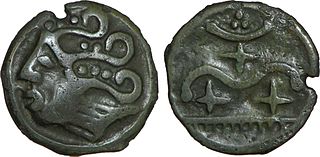Related Research Articles

The Lingones were a Gallic tribe of the Iron Age and Roman periods. They dwelled in the region surrounding the present-day city of Langres, between the provinces of Gallia Lugdunensis and Gallia Belgica.
The Viducassēs were a Gallic tribe dwelling in the modern Calvados department during the Iron Age and the Roman period.

The Senones or Senonii were an ancient Gallic tribe dwelling in the Seine basin, around present-day Sens, during the Iron Age and the Roman period.

The Aulerci Cenomani were a Gallic tribe dwelling in the modern Sarthe department during the Iron Age and the Roman period. The Cenomani were the most powerful of the Aulerci tribes.

The Petrocorii were a Gallic tribe dwelling in the present-day Périgord region, between the Dordogne and Vézère rivers, during the Iron Age and the Roman period.

The Bodiocasses or Baiocasses were an ancient Gallic tribe of the Roman period. They were a tribal division of the civitas of the Lexovii, in the Roman province of Gallia Lugdunensis.

The Mediomatrici were according to Caesar a Gaulish tribe at the frontier to the Belgicae dwelling in the present-day regions Lorraine, Upper Moselle during the Iron Age and the Roman period.
The Caletes or Caleti were a Belgic or Gallic tribe dwelling in Pays de Caux, in present-day Normandy, during the Iron Age and the Roman period.

The Lemovīcēs were a Gallic tribe dwelling in the modern Limousin region during the Iron Age and the Roman period.

The Eburovīcēs or Aulercī Eburovīcēs were a Gallic tribe dwelling in the modern Eure department during the Iron Age and the Roman period. They were part of the Aulerci.
The Lexovii, were a Gallic tribe dwelling immediately west of the mouth of the Seine, around present-day Lisieux, during the Iron Age and the Roman period.

The Coriosolites or Curiosolitae were a Gallic people dwelling on the northern coast of present-day Brittany during the Iron Age and the Roman period.

The Andecavi were a Gallic tribe dwelling in Aremorica during the Roman period.
The Tricastini were a small Gallic tribe dwelling in the modern Tricastin region, near present-day Saint-Paul-Trois-Châteaux, during the Iron Age and the Roman period.

The Gabali were a Gallic tribe dwelling in the later Gévaudan region during the Iron Age and the Roman period.

The Segusiavī were a Gallic tribe dwelling around the modern city of Feurs (Auvergne-Rhône-Alpes) during the Iron Age and the Roman period.
The Veliocasses or Velocasses were a Belgic or Gallic tribe of the La Tène and Roman periods, dwelling in the south of modern Seine-Maritime and in the north of Eure.

The Cadurci were a Gallic tribe dwelling in the later region of Quercy during the Iron Age and the Roman period.

The Durocasses were a Gallic tribe dwelling around present-day Dreux during the Roman period.
The Silvanectes were a small Belgic tribe dwelling around present-day Senlis (Oise) during the Roman period.
References
- 1 2 3 Polfer 2006.
- ↑ Pliny. Naturalis Historia, 4:107.
- ↑ Ptolemy. Geōgraphikḕ Hyphḗgēsis, 2:8:10.
- ↑ Falileyev 2010, s.v. Tricasses.
- ↑ Delamarre 2003, p. 301.
- ↑ Delamarre 2003, pp. 109–110: "H. Birkhan parvient cependant à la conclusion raisonnable que -casses et cassi- sont deux mots différents, que -casses signifie probablement 'au cheveux bouclés / crépus' ("mit wirrem Kraushaar") et s'explique par la coiffure spéciale des Celtes au combat (une forme celto-germanique *kazdh- permettrait d'unifier le celtique -cass- et les mots v.norr. haddr 'longs cheveux de femme', ags. heord 'chevelure' < *kazdh-to-/ti-)."
- ↑ Nègre 1990, p. 157.
Bibliography
- Delamarre, Xavier (2003). Dictionnaire de la langue gauloise: Une approche linguistique du vieux-celtique continental (in French). Errance. ISBN 9782877723695.
- Falileyev, Alexander (2010). Dictionary of Continental Celtic Place-names: A Celtic Companion to the Barrington Atlas of the Greek and Roman World. CMCS. ISBN 978-0955718236.
- Nègre, Ernest (1990). Toponymie générale de la France (in French). Librairie Droz. ISBN 978-2-600-02883-7.
- Polfer, Michel (2006). "Tricasses". Brill's New Pauly. doi:10.1163/1574-9347_bnp_e1220270.
